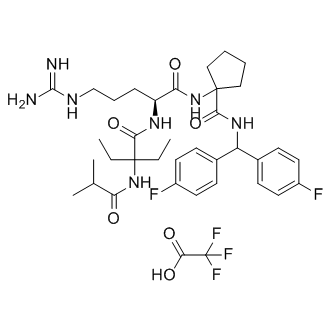
MM-102 trifluoroacetate
CAS No. ——
MM-102 trifluoroacetate( —— )
Catalog No. M17058 CAS No. ——
A high-affinity, small-molecule peptidomimetic inhibitor of MLL1/WDR5 protein-protein interaction with Ki of 2.4 nM.
Purity : >98% (HPLC)
 COA
COA
 Datasheet
Datasheet
 HNMR
HNMR
 HPLC
HPLC
 MSDS
MSDS
 Handing Instructions
Handing Instructions
| Size | Price / USD | Stock | Quantity |
| 100MG | Get Quote | Get Quote |


|
| 200MG | Get Quote | Get Quote |


|
| 500MG | Get Quote | Get Quote |


|
| 1G | Get Quote | Get Quote |


|
Biological Information
-
Product NameMM-102 trifluoroacetate
-
NoteResearch use only, not for human use.
-
Brief DescriptionA high-affinity, small-molecule peptidomimetic inhibitor of MLL1/WDR5 protein-protein interaction with Ki of 2.4 nM.
-
DescriptionA high-affinity, small-molecule peptidomimetic inhibitor of MLL1/WDR5 protein-protein interaction with Ki of 2.4 nM; effectively decreases the expression of HoxA9 and Meis-1; specifically inhibits cell growth and induces apoptosis in leukemia cells harboring MLL1 fusion proteins.
-
In Vitro——
-
In Vivo——
-
Synonyms——
-
PathwayChromatin/Epigenetic
-
TargetHMTase
-
RecptorHMTase
-
Research Area——
-
Indication——
Chemical Information
-
CAS Number——
-
Formula Weight783.8282
-
Molecular FormulaC37H50F5N7O6
-
Purity>98% (HPLC)
-
Solubility10 mM in DMSO
-
SMILES——
-
Chemical Name(S)-N-(bis(4-fluorophenyl)methyl)-1-(2-(2-ethyl-2-isobutyramidobutanamido)-5-guanidinopentanamido)cyclopentanecarboxamide 2,2,2-trifluoroacetate
Shipping & Storage Information
-
Storage(-20℃)
-
ShippingWith Ice Pack
-
Stability≥ 2 years
Reference
1. Karatas H, et al. J Am Chem Soc. 2013 Jan 16;135(2):669-82.
molnova catalog



related products
-
EPZ015666
EPZ015666 (GSK3235025) is a potent, selective, orally available inhibitor of PRMT5 with Ki/IC50 of 5/22 nM.
-
TP-064
TP-064 is a potent, selective, and cell-active inhibitor of PRMT4 with IC50 of <10 nM and Kd of 7.1 nM.
-
LLY-507
A potent, selective and cell-active inhibitor of SMYD2 (IC50<15 nM).



 Cart
Cart
 sales@molnova.com
sales@molnova.com


